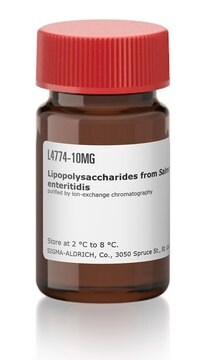L2012
Lipopolysaccharides from Salmonella enterica serotype enteritidis
purified by gel-filtration chromatography
Sinonimo/i:
LPS
About This Item
Prodotti consigliati
Origine biologica
Salmonella enterica (Serotype enteritidis)
Livello qualitativo
Forma fisica
lyophilized powder
Purificato mediante
gel-filtration chromatography
Impurezze
<1% Protein
Colore
white to faint yellow
Solubilità
water: 4.90-5.10 mg/mL, cloudy to hazy, colorless to faintly yellow
Condizioni di spedizione
ambient
Temperatura di conservazione
2-8°C
Cerchi prodotti simili? Visita Guida al confronto tra prodotti
Descrizione generale
Applicazioni
Azioni biochim/fisiol
Nota sulla preparazione
Altre note
Prodotti correlati
Codice della classe di stoccaggio
11 - Combustible Solids
Classe di pericolosità dell'acqua (WGK)
WGK 3
Punto d’infiammabilità (°F)
Not applicable
Punto d’infiammabilità (°C)
Not applicable
Certificati d'analisi (COA)
Cerca il Certificati d'analisi (COA) digitando il numero di lotto/batch corrispondente. I numeri di lotto o di batch sono stampati sull'etichetta dei prodotti dopo la parola ‘Lotto’ o ‘Batch’.
Possiedi già questo prodotto?
I documenti relativi ai prodotti acquistati recentemente sono disponibili nell’Archivio dei documenti.
I clienti hanno visto anche
Il team dei nostri ricercatori vanta grande esperienza in tutte le aree della ricerca quali Life Science, scienza dei materiali, sintesi chimica, cromatografia, discipline analitiche, ecc..
Contatta l'Assistenza Tecnica.

